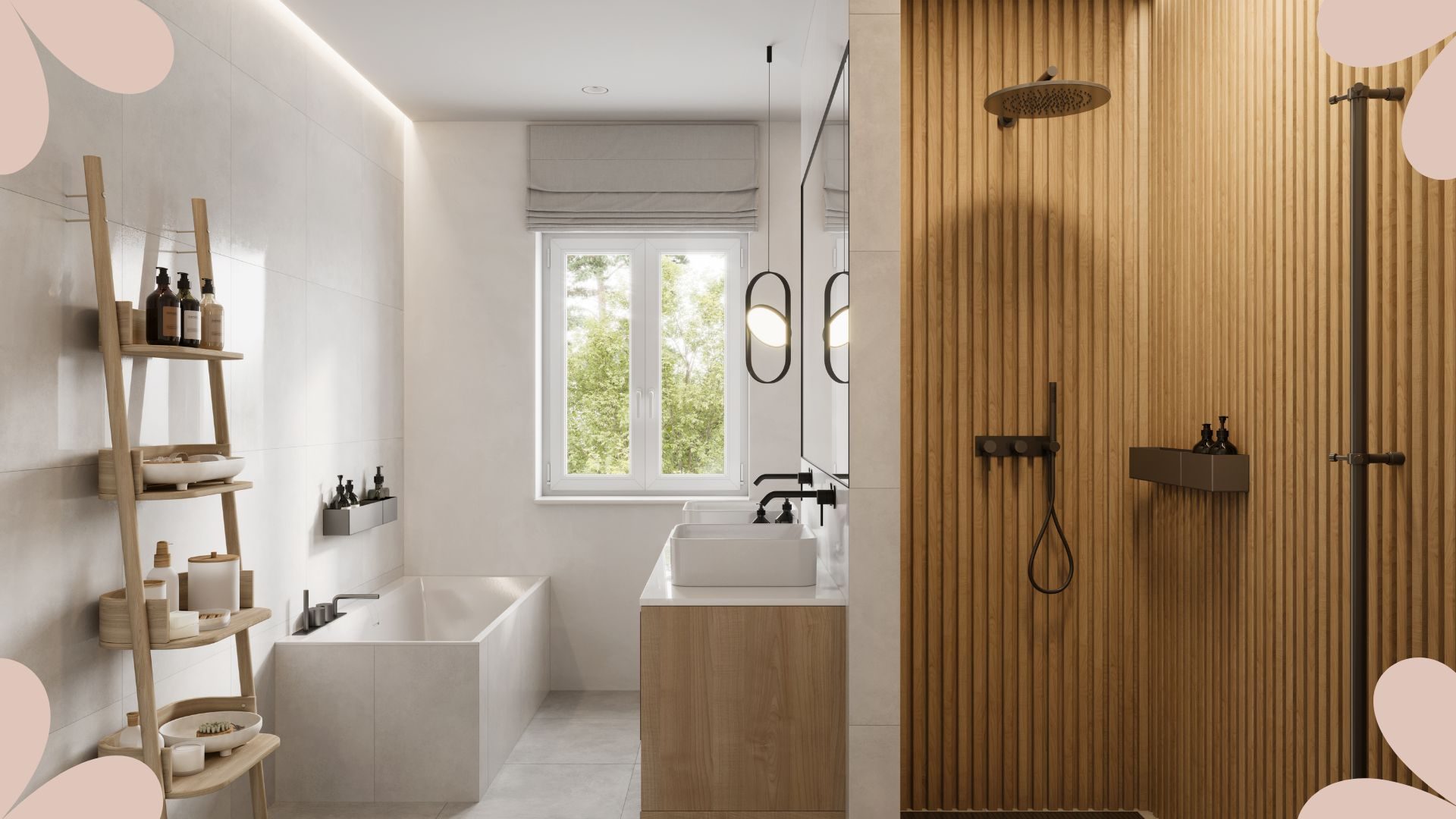The Japandi aesthetic has emerged as one of the most compelling design movements in recent years, marrying the minimalist principles of Japanese wabi-sabi with the clean functionality of Scandinavian design.
This harmonious fusion creates spaces that are both serene and practical—nowhere is this more transformative than in the bathroom.
The juxtaposition of these two distinct yet complementary philosophies yields environments that emphasize tranquility, natural materials, and meticulous craftsmanship while maintaining an uncluttered, purposeful ambiance.
As our bathrooms evolve from purely utilitarian spaces to personal sanctuaries, the Japandi approach offers a blueprint for creating bathrooms that serve as daily retreats from the cacophony of modern life.
Japandi Bathroom Ideas
In this article, we’ll explore fifteen inspiring ideas to incorporate this sophisticated aesthetic into your bathroom, regardless of its size or your renovation budget.
1. Natural Wood Elements
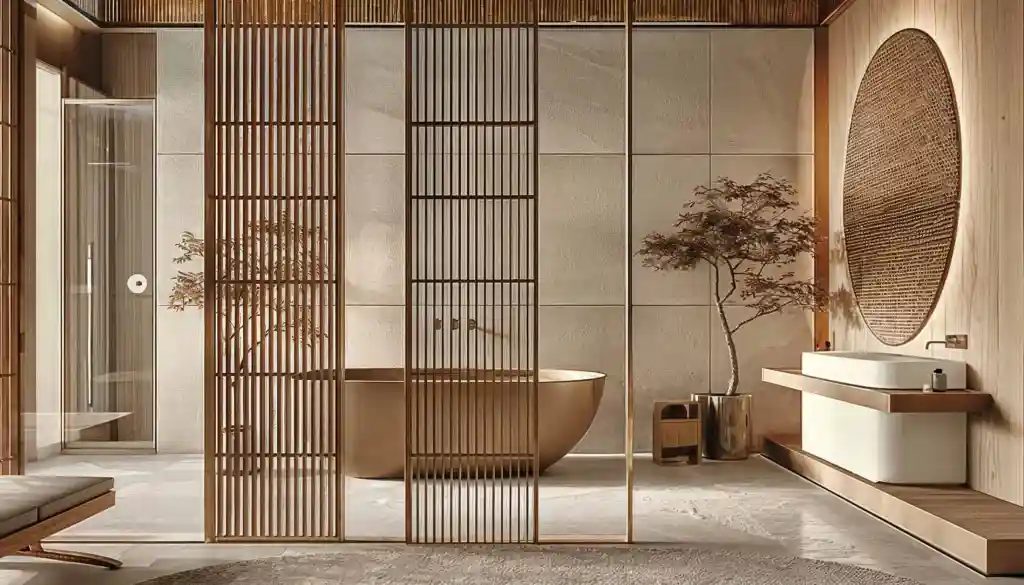
The foundation of any Japandi bathroom begins with the thoughtful incorporation of wood. Opt for light to medium-toned varieties like oak, cedar, or teak that bring warmth without overwhelming the space. These woods create an immediate connection to nature while providing the perfect neutral backdrop for both Japanese and Scandinavian design elements.
Consider incorporating wood in unexpected ways beyond the obvious vanity or storage solutions. Wooden bath mats, ceiling treatments, or even carefully placed shelving can introduce this essential material without major renovations. The key is to maintain the wood’s natural appearance, with minimal staining that allows the grain patterns and inherent characteristics to become design features themselves.
2. Neutral Color Palette
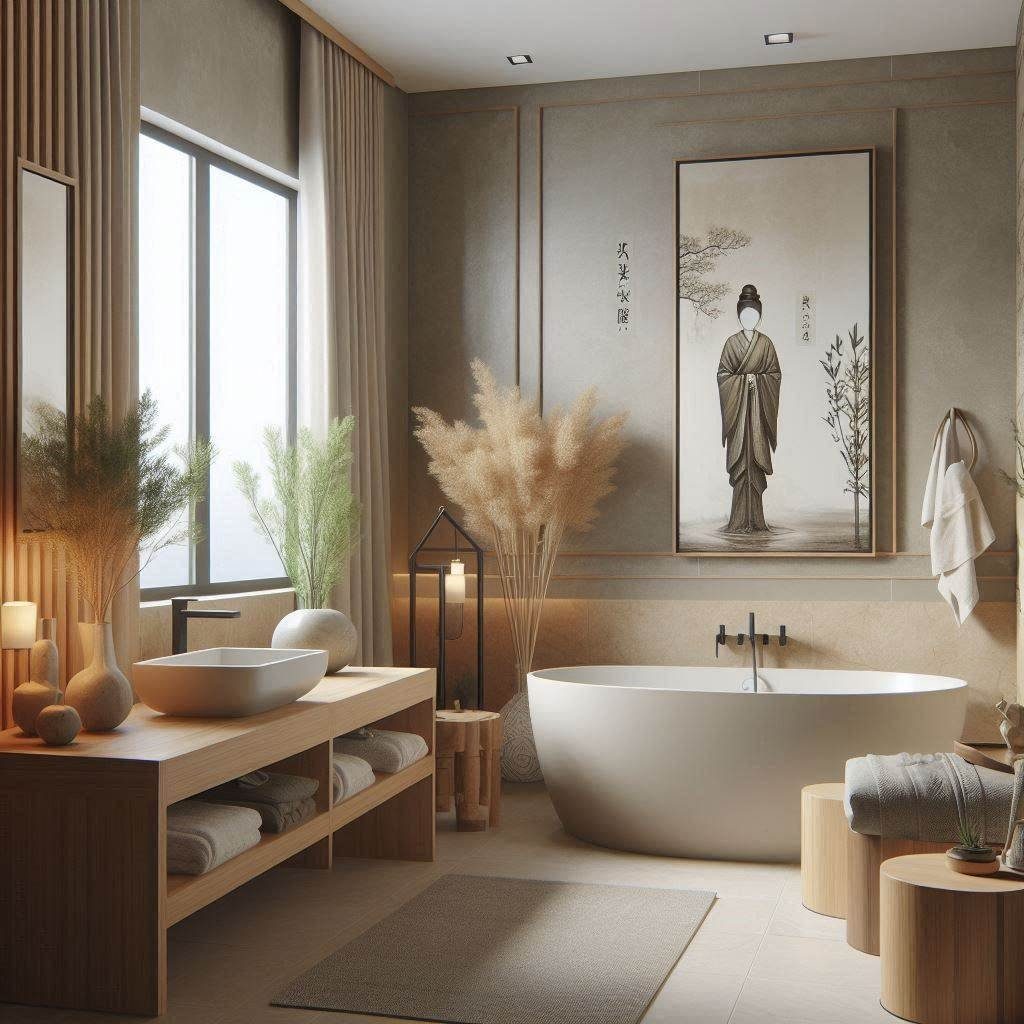
The Japandi aesthetic thrives within a carefully curated neutral color scheme that evokes a sense of calm and spaciousness. White, cream, beige, and soft gray should dominate the space, creating a canvas that feels open and uncluttered. These neutral tones can be complemented by subtle earthy accents—think gentle terracotta, muted sage, or soft charcoal—to add dimension without disrupting the tranquil atmosphere.
When selecting your neutral palette, pay particular attention to undertones. Warm neutrals create a more inviting, cozy bathroom, while cooler neutrals offer a crisp, clean appearance.
The uniformity of color across different surfaces—walls, floors, and fixtures—reinforces the minimalist principles central to Japandi design while allowing textural elements and carefully chosen accessories to stand out as intentional focal points.
3. Minimal Decor Philosophy

Embracing “less is more” is essential when creating an authentic Japandi bathroom. Select each decorative element with purpose, ensuring it serves either a functional role or carries significant aesthetic value. This disciplined approach to decoration creates spaces that feel intentional rather than sterile, with each item earning its place through usefulness or beauty—ideally both.
The resulting negative space becomes a design element itself, creating visual breathing room that’s crucial for mental relaxation. Consider displaying only a few carefully chosen items: perhaps a single plant, a handcrafted ceramic vessel, or a beautifully woven basket. Remember that in Japandi design, empty space isn’t viewed as something to fill but rather as an active component that balances the composition and allows the mind to rest.
4. Statement Soaking Tub
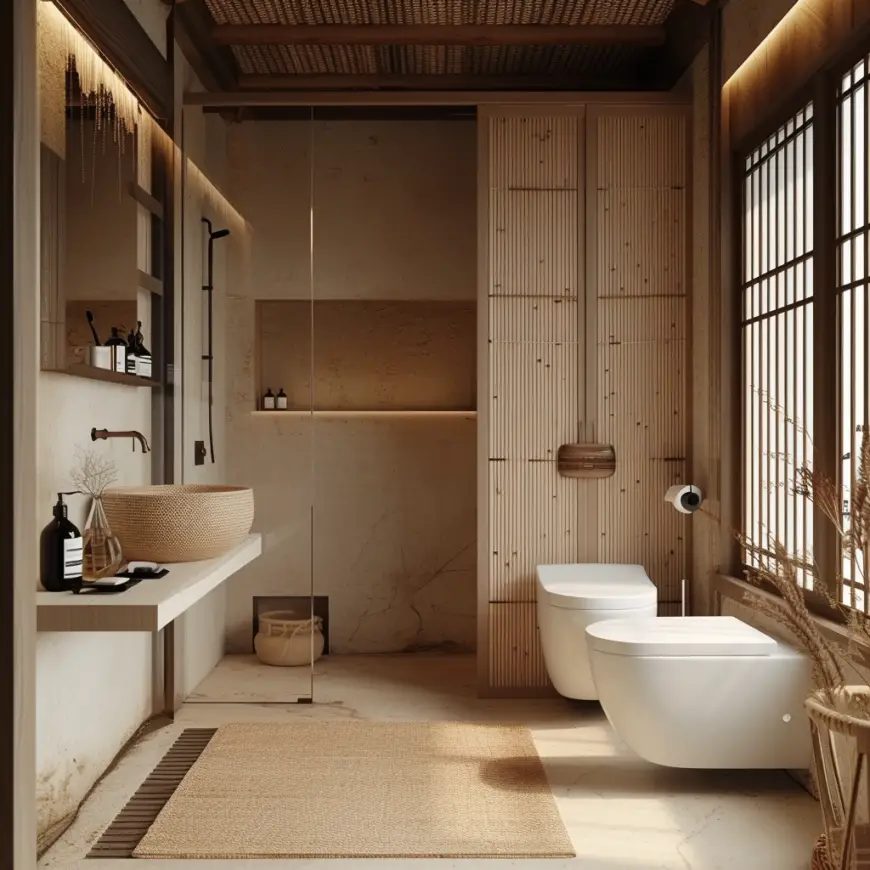
A deep soaking tub often becomes the centerpiece of a Japandi bathroom, drawing inspiration from the Japanese ofuro tradition while incorporating Scandinavian practicality. Freestanding tubs with simple, architectural lines work perfectly within this aesthetic, particularly when crafted from natural materials like stone, wood-surrounded metal, or high-quality composite materials with organic appearances.
Position your tub to maximize both functionality and the visual experience—perhaps near a window with privacy elements that still allow natural light, or as a focal point visible upon entering the bathroom.
The surrounding space should remain uncluttered, emphasizing the tub’s importance as both a functional fixture and a statement piece that embodies the ritualistic approach to bathing central to Japanese culture and the wellness-focused lifestyle embraced by Scandinavians.
Related Guide: 15 His and Hers Bathroom Ideas
5. Indoor Plants and Natural Elements
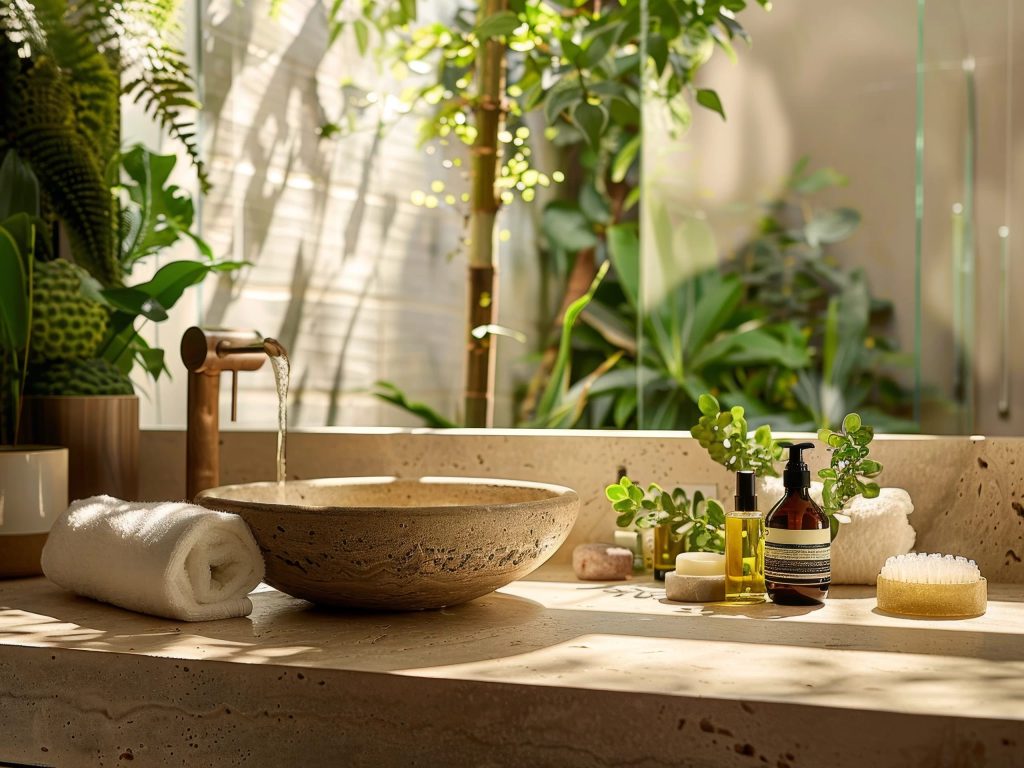
Bringing living greenery into your Japandi bathroom creates an immediate connection to the natural world while softening the minimalist lines of the space. Choose species that thrive in bathroom conditions, such as bamboo, aloe vera, or peace lilies. These plants not only add visual interest but also improve air quality and enhance the sense of wellbeing associated with Japandi spaces.
Display your botanical selections in simple vessels that complement your design scheme—think handmade ceramic pots, bamboo planters, or minimalist concrete containers.
Position them thoughtfully, perhaps on a wooden stool, floating shelf, or beside the bath where they can be appreciated during moments of relaxation. Consider also incorporating other natural elements like stones, dried flowers, or small branches arranged with the intentional simplicity characteristic of Japanese ikebana.
6. Clean Lines and Hidden Storage
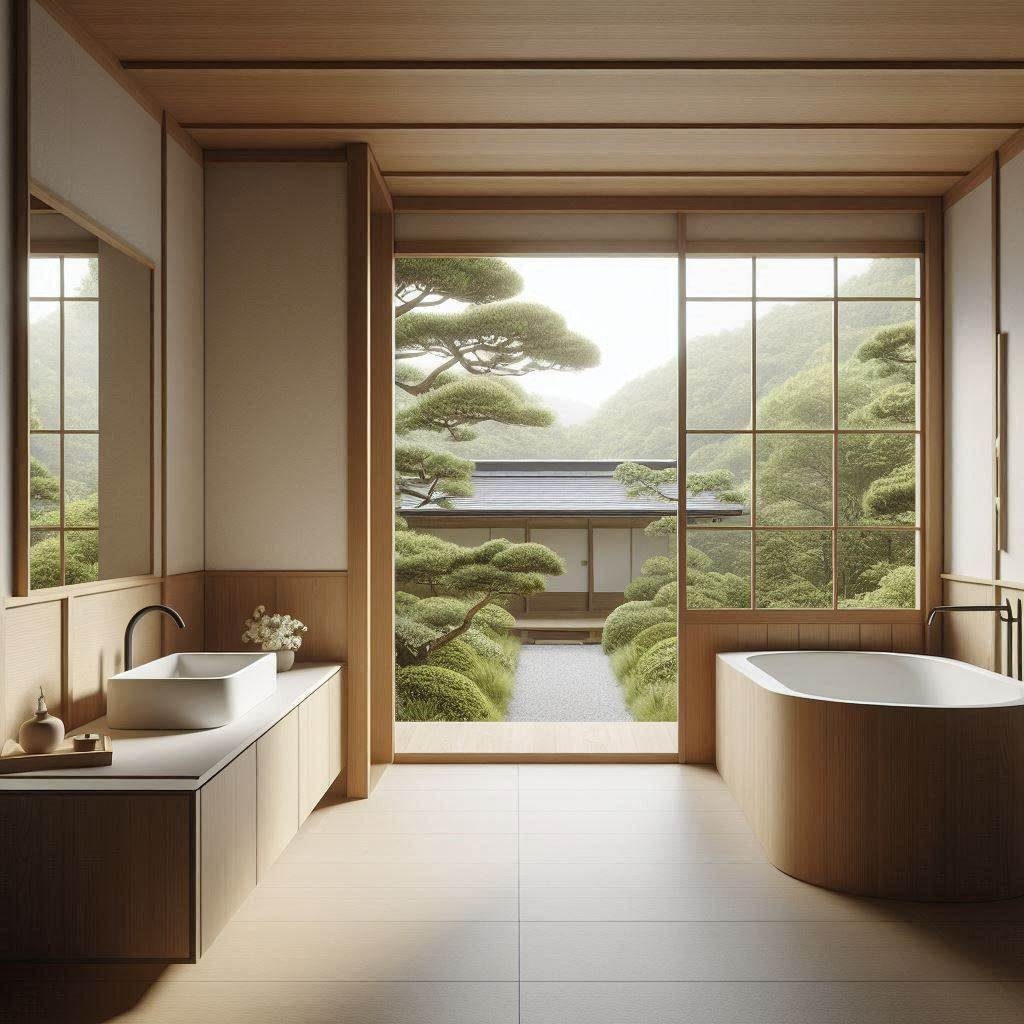
The hallmark of Japandi bathroom design lies in its clean, uninterrupted lines that create a sense of order and visual calm. Achieve this through built-in storage solutions, wall-mounted fixtures, and furniture with intentionally simple forms. Look for vanities and cabinetry with minimal hardware or finger-pull openings that maintain the streamlined aesthetic.
Incorporate clever hidden storage to maintain the clutter-free environment essential to this design philosophy. Consider medicine cabinets disguised within wall paneling, pull-out compartments within benches, or floating vanities with integrated organization systems.
The goal is to have a dedicated place for every bathroom necessity while keeping countertops and visible surfaces largely clear, allowing the materials and architectural elements to become the focus rather than everyday items.
7. Thoughtful Lighting Design
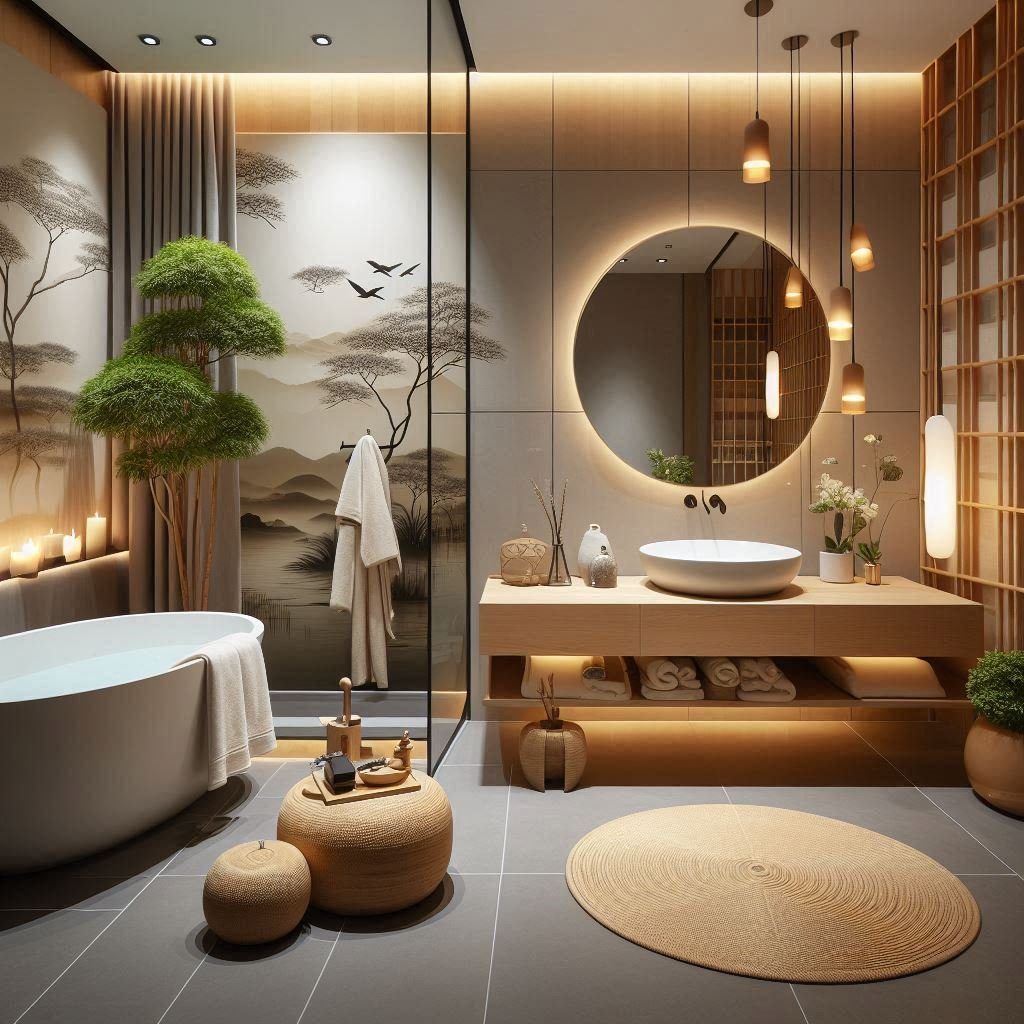
Lighting in a Japandi bathroom should mimic natural illumination while providing practical functionality for daily routines. Layer different light sources to create a flexible scheme: ambient lighting for general illumination, task lighting for grooming activities, and accent lighting to highlight architectural features or special elements.
Select fixtures with simple, geometric forms in natural materials like paper (for sconces inspired by Japanese lanterns), wood, or matte black metal. Consider incorporating dimmers to adjust the atmosphere according to different needs and times of day. The interplay of light and shadow is particularly important in Japanese design—allow for some strategic shadowing that adds depth and interest while maintaining the overall serene and functional environment.
8. Natural Stone Accents
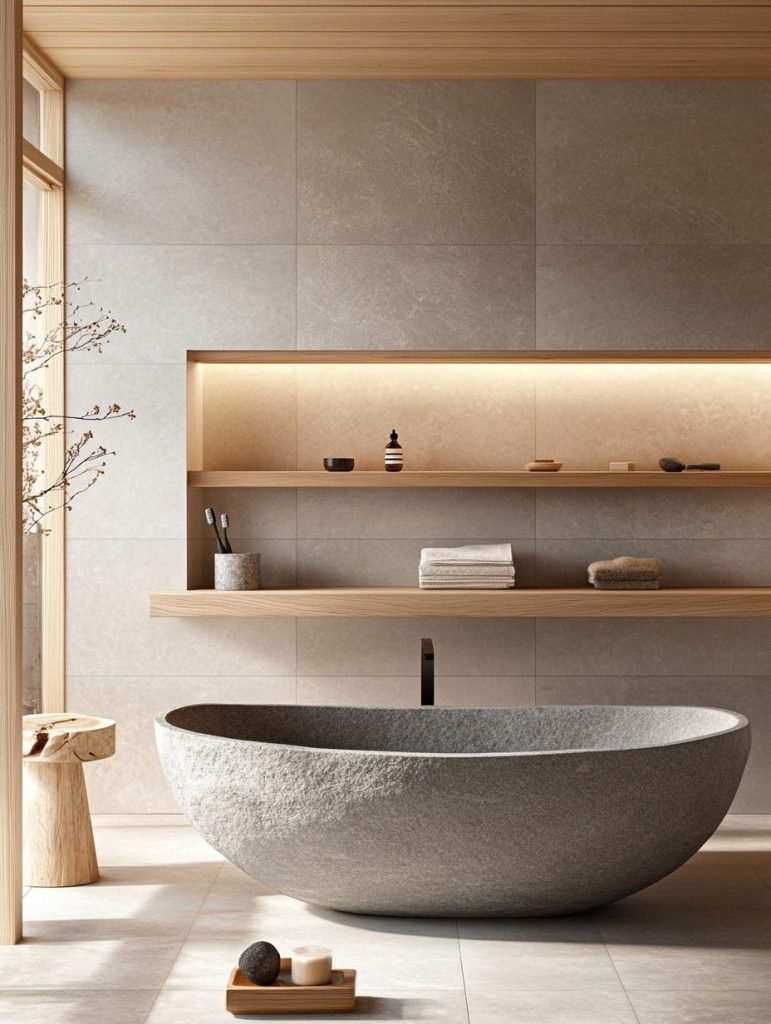
Incorporating stone elements adds textural interest and enduring quality to your Japandi bathroom. Consider a stone countertop, shower surround, or flooring in materials like limestone, slate, or honed marble in neutral tones. These natural elements bring subtle color variation and organic patterning that adds depth without disturbing the minimalist approach.
For smaller budgets or less permanent applications, introduce stone through accessories like soap dishes, trays, or decorative objects. The imperfect, slightly varied appearance of natural stone aligns perfectly with the Japanese wabi-sabi philosophy that finds beauty in imperfection, while its durability satisfies the Scandinavian emphasis on quality craftsmanship and longevity.
9. Matte Black Fixtures
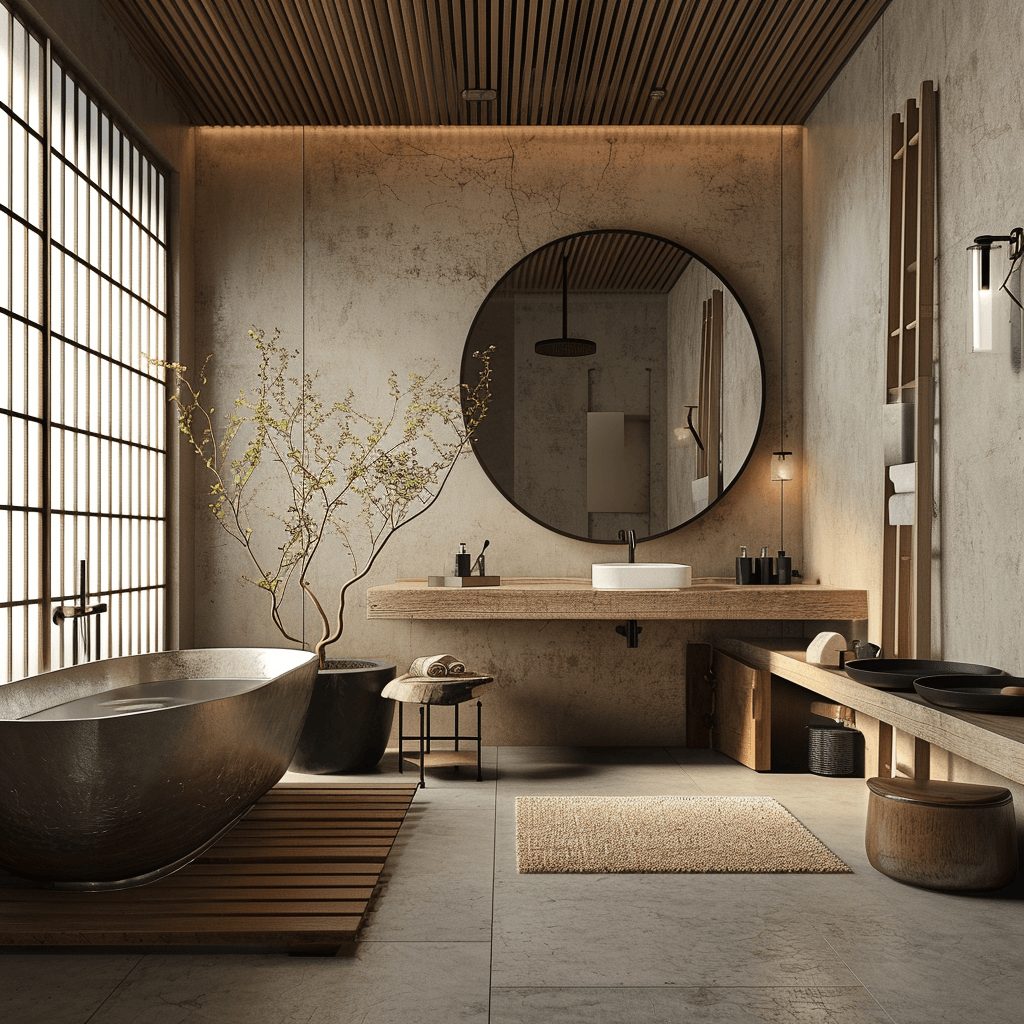
Matte black plumbing fixtures and hardware create dramatic contrast against neutral backgrounds while maintaining the understated elegance central to Japandi design. Their non-reflective finish appears more integrated and intentional than shiny alternatives, creating subtle definition without overwhelming the senses.
When selecting black fixtures, maintain consistency throughout the space—faucets, shower systems, towel bars, and even drain covers should share the same finish. This cohesion reinforces the thoughtful, curated nature of the design. For maximum impact, pair these dark elements with lighter surfaces that create striking visual contrast while adhering to the minimalist color palette.
10. Bamboo or Wooden Accessories
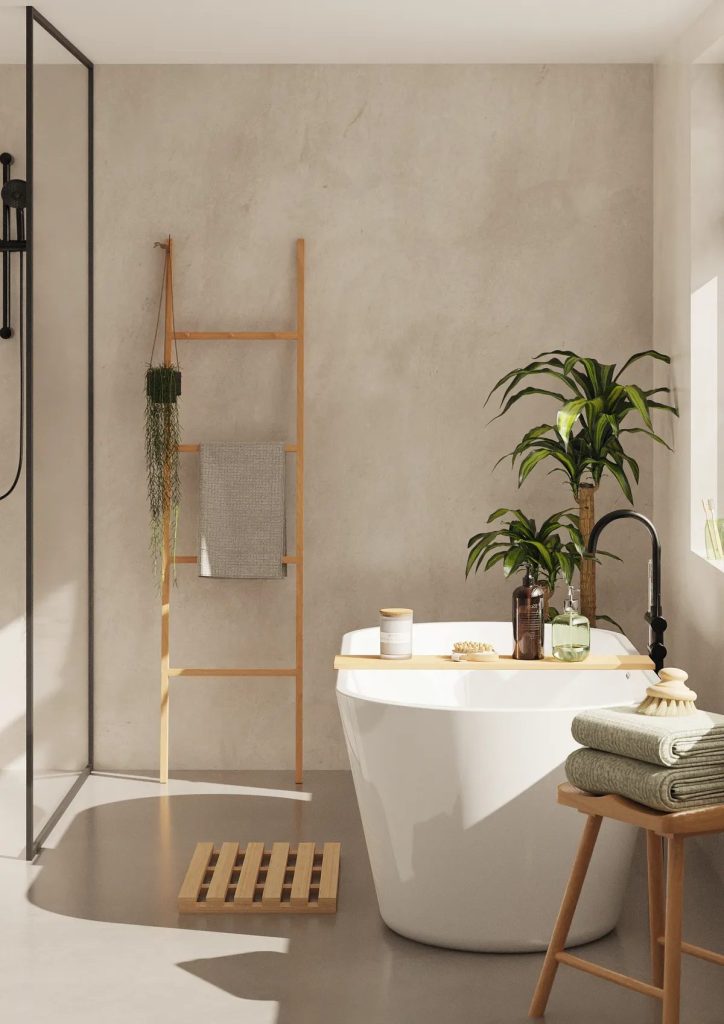
Integrating bamboo or wooden accessories adds warmth and natural texture while reinforcing the sustainable aspects of Japandi design. Look for items that serve practical purposes: wooden bath caddies, bamboo toothbrush holders, natural sponges, or handcrafted wooden combs and brushes. These elements introduce the organic quality essential to both Japanese and Scandinavian aesthetics.
Choose accessories with simple forms and minimal ornamentation that showcase the natural beauty of the materials themselves. The slight variations in grain, color, and texture present in these natural products add visual interest without requiring decorative embellishment, perfectly aligning with the “beauty in simplicity” principle that defines the Japandi approach.
11. Textural Contrast Through Textiles
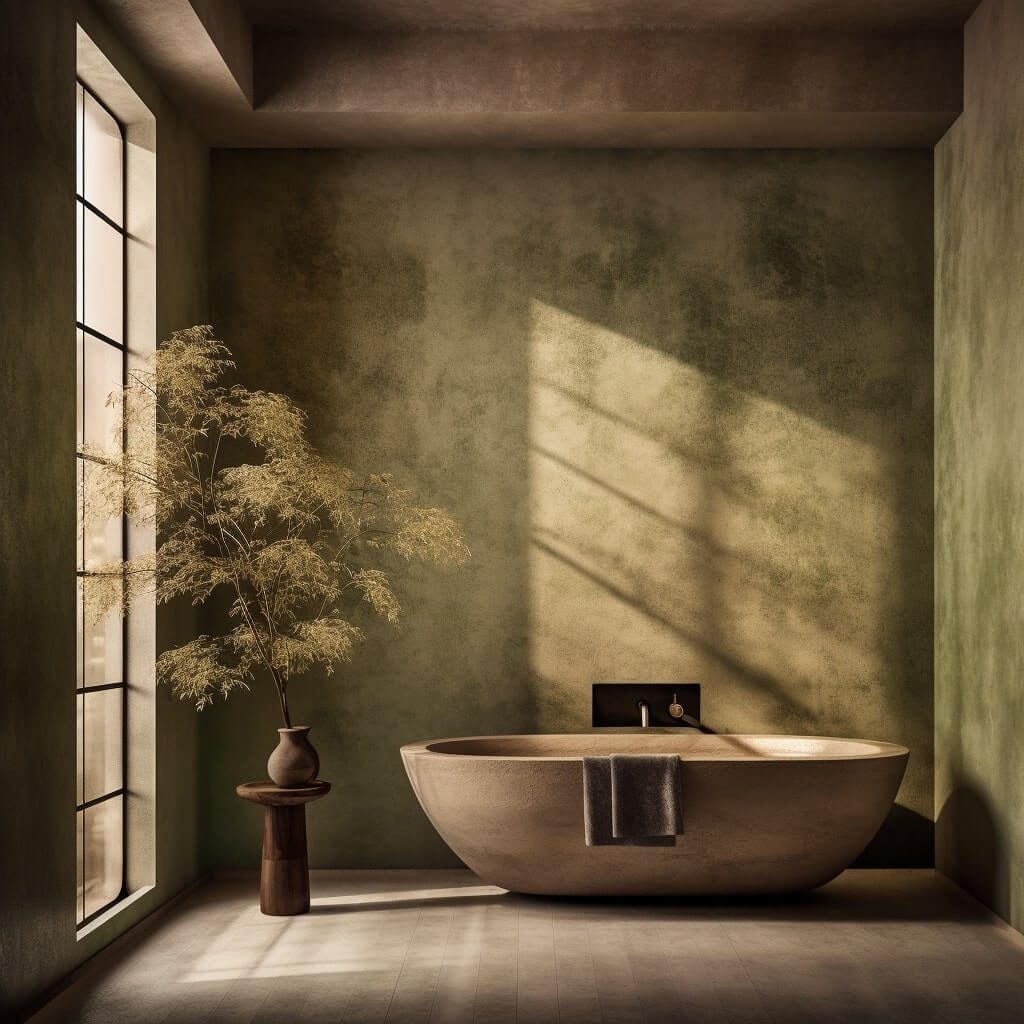
While maintaining the neutral color scheme, introduce visual and tactile interest through carefully selected textiles with varied textures. High-quality towels in organic cotton or linen, a simple bath mat in natural materials, or a handwoven basket for storage all contribute to the layered sensory experience that elevates a Japandi bathroom beyond mere minimalism.
Consider contrasting smooth surfaces like porcelain or glass with rougher textures like raw wood, unglazed ceramics, or woven elements. This juxtaposition creates subtle visual dynamics that reward close attention and create a more sophisticated design outcome. Choose textiles with simple patterns if desired—perhaps a subtle geometric design or traditional Japanese-inspired motif—but keep them understated and within your established color palette.
Related Guide: 14 Moody Green Bathroom Ideas
12. Integrated Bench Seating
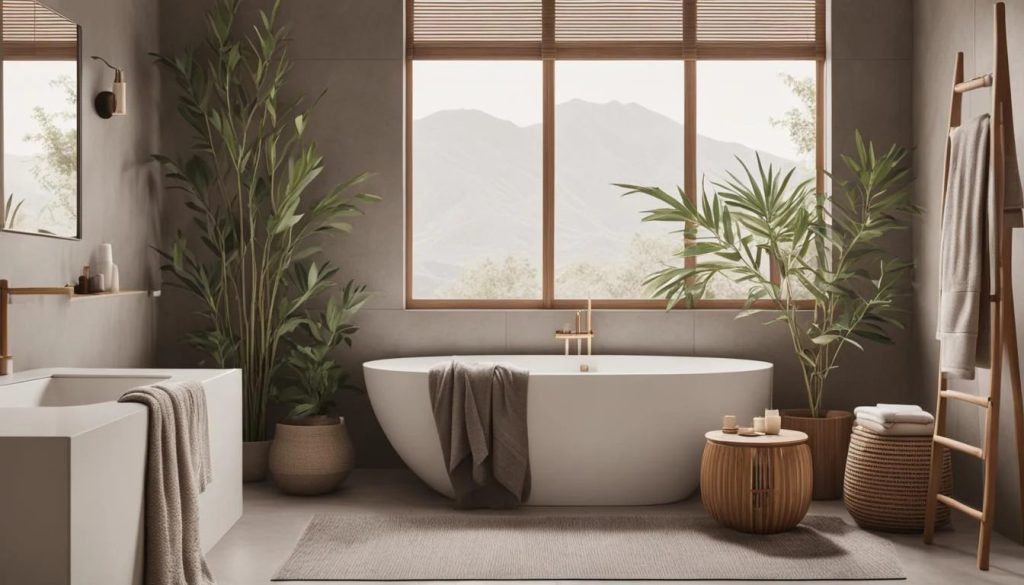
A thoughtfully placed wooden bench or built-in seating area adds both functionality and sculptural interest to a Japandi bathroom. This feature nods to the bathing traditions of Japan while incorporating the practical furniture sensibilities of Scandinavian design. A simple bench provides a place to sit while preparing for bathing or a surface for towels and accessories.
Design this element with clean lines and quality materials, ensuring it harmonizes with other wooden elements in the space. Consider how it interacts with surrounding features—perhaps it extends from a vanity, wraps around a corner, or sits beneath a window where natural light can highlight its craftsmanship. This multifunctional piece embodies the Japandi principle that beautiful items should also serve practical purposes.
13. Glass Shower Enclosures
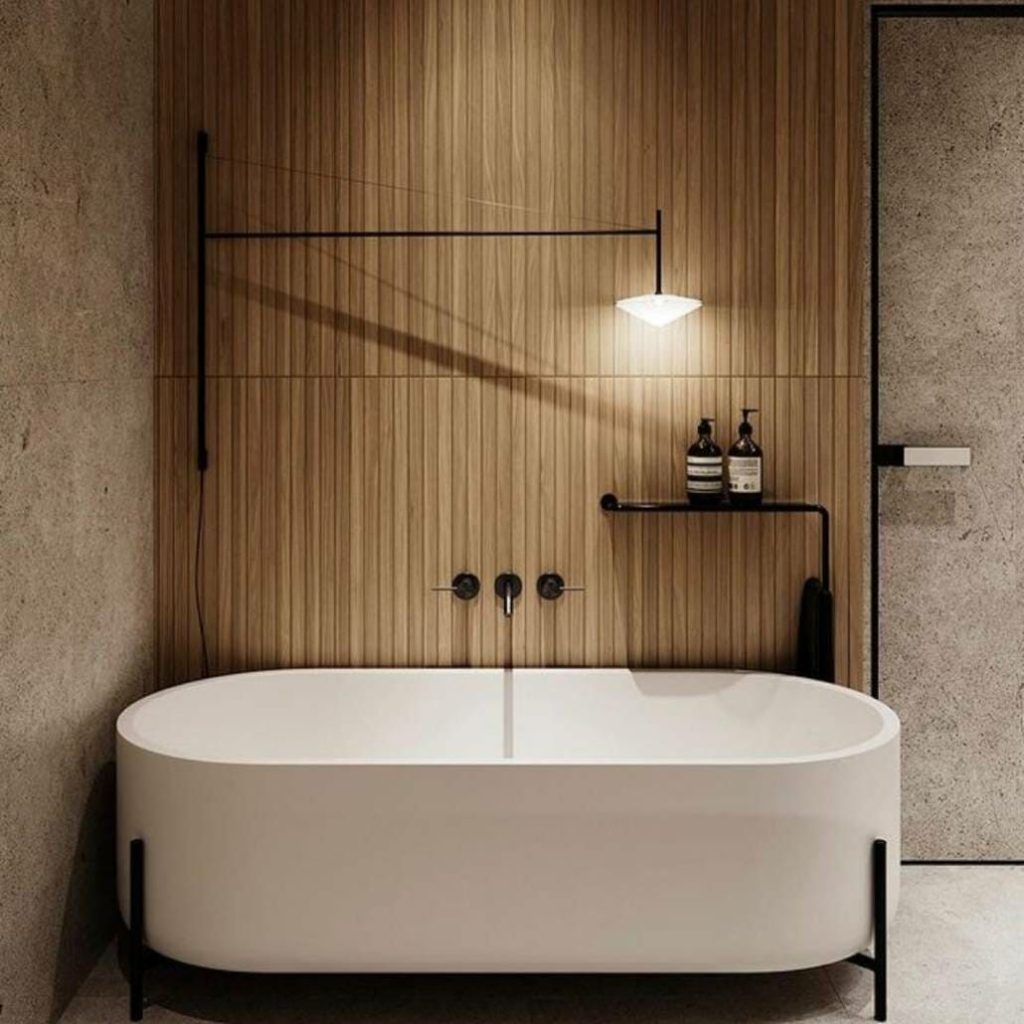
Frameless glass shower enclosures maintain visual flow throughout the bathroom while creating distinct functional zones. This architectural approach maximizes the perception of space while allowing natural light to penetrate all areas, enhancing the airy quality prized in both Japanese and Scandinavian interiors.
Within the shower itself, continue the material language established in the broader bathroom—perhaps extending the same flooring material inside or using complementary tiles in similar tones.
Minimal hardware in matte black or brushed metal keeps the focus on the clean lines and spatial quality rather than decorative elements, reinforcing the restrained elegance that characterizes Japandi design.
14. Handcrafted Ceramic Elements
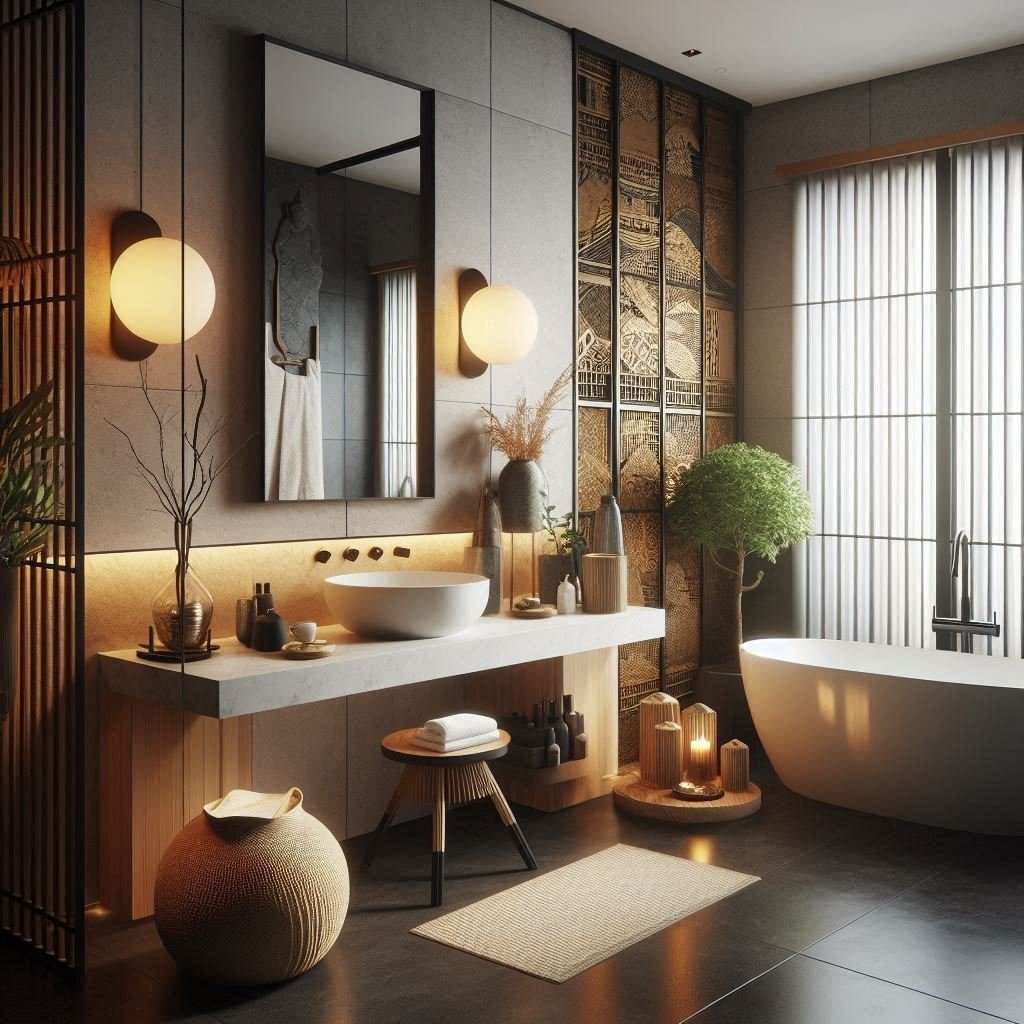
Incorporating handmade ceramics introduces the human touch and celebrates imperfection in alignment with Japanese wabi-sabi principles. Look for vessel sinks, soap dispensers, or decorative containers with subtle irregularities that reveal their artisanal origins. These pieces often feature muted glazes in earthy tones or simple finishes that highlight the natural clay.
Display these items prominently where their craftsmanship can be appreciated—a handmade vessel sink becomes a focal point atop a simple vanity, while a collection of ceramic containers gains impact when arranged with intentional simplicity on an otherwise bare shelf.
These elements add character and depth to the space while honoring the cultural appreciation for handicraft shared by both Japanese and Scandinavian traditions.
15. Asymmetrical Balance
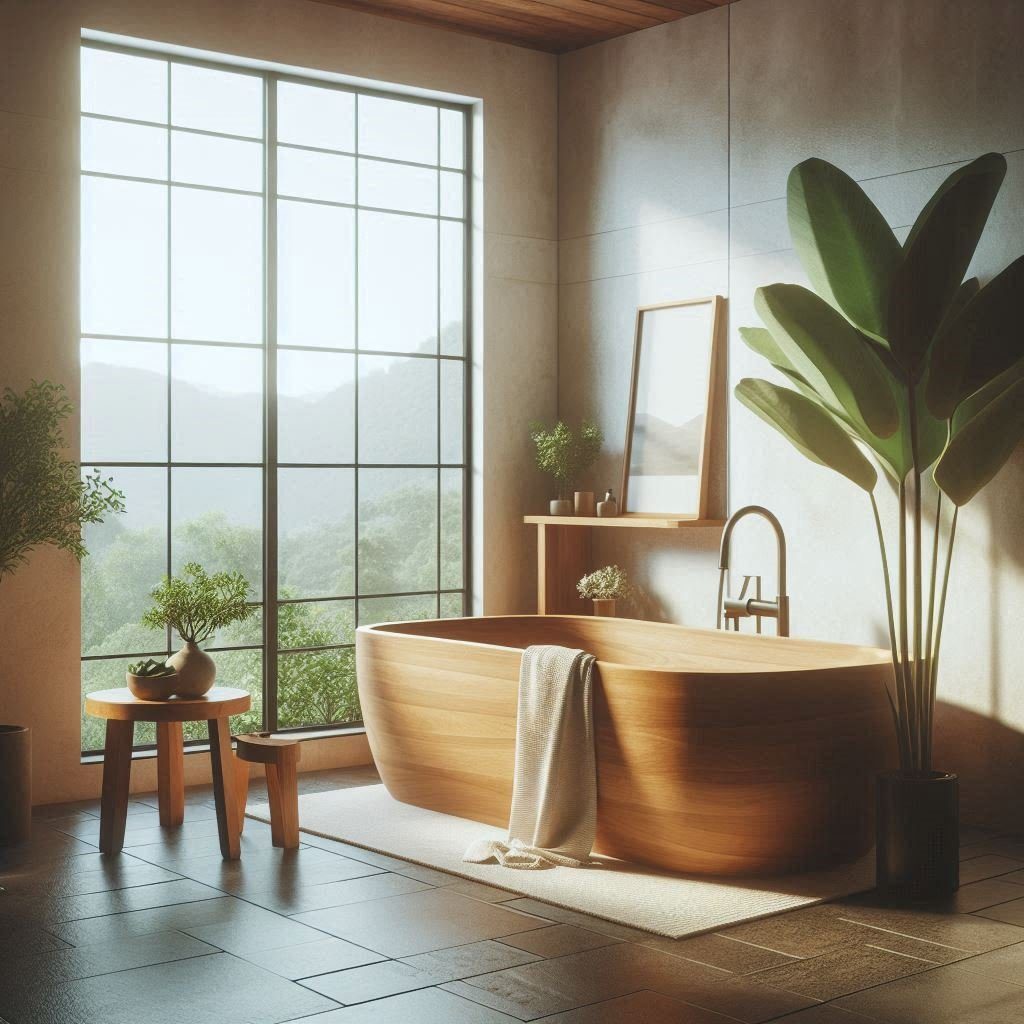
While Japandi design values order and simplicity, it avoids rigid symmetry in favor of thoughtfully balanced asymmetrical arrangements. This approach, deeply rooted in Japanese design principles, creates more dynamic, organic-feeling spaces that maintain harmony without appearing formulaic or static.
Implement this concept by positioning your vanity off-center while balancing it with a plant or stool on the opposite side, or installing a mirror that aligns with one edge of your sink rather than centering it.
This deliberate asymmetry, when executed with care, creates spaces that feel both composed and naturally evolved rather than mathematically calculated, adding subtle visual interest while maintaining the peaceful atmosphere central to the Japandi aesthetic.
Conclusion
The Japandi bathroom represents more than just a design trend—it offers a thoughtful approach to creating spaces that nurture wellbeing and mindfulness through intentional design choices.
By blending Japanese tranquility with Scandinavian functionality, these bathrooms become daily retreats that encourage presence and appreciation for simple pleasures.
Whether you incorporate just a few elements or embrace the aesthetic completely, the principles of natural materials, mindful minimalism, and quality craftsmanship will elevate your bathroom experience.
As we continue seeking balance in our increasingly complex lives, the Japandi approach reminds us that our most intimate spaces can be designed not just for efficiency but for the nourishment of our spirits through beauty, simplicity, and connection to natural elements.

